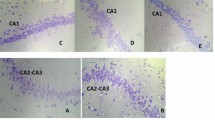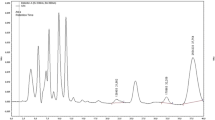Abstract
The impact of astaxanthin-enriched algal powder on auxiliary memory improvement was assessed in BALB/c mice pre-supplemented with different dosages of cracked green algal (Haematococcus pluvialis) powder daily for 30 days. The supplemented mice were first tested over 8 days to find a hidden platform by swimming in a Morris water maze. Then, for 5 days, the mice were used to search for a visible platform in a Morris water maze. After that, the mice practised finding a safe place—an insulated platform in a chamber—for 2 days. During these animal experimental periods, similar algal meals containing astaxanthin at 0, 0.26, 1.3 and 6.4 mg/kg body weight were continuously fed to each group of tested mice. Profiles of latency, distance, speed and the direction angle to the platforms as well as the diving frequency in each group were measured and analyzed. The process of mice jumping up onto the insulated platform and diving down to the copper-shuttered bottom with a 36 V electrical charge were also monitored by automatic video recording. The results of the Morris maze experiment showed that middle dosage of H. pluvialis meals (1.3 mg astaxanthin/kg body weight) significantly shortened the latency and distance required for mice to find a hidden platform. However, there was no obvious change in swim velocity in any of the supplemented groups. In contrast, the visible platform test showed a significant increase in latency and swim distance, and a significant decrease in swim speed for all groups of mice orally supplemented with H. pluvialis powder compared to the placebo group (P < 0.05 or P < 0.01). Mice supplemented with the algal meal hesitantly turned around the original hidden platform, in contract to mice supplemented with placebo, who easily forgot the original location and accepted the visible platform as a new safe place. These results illustrate that astaxanthin-enriched H. pluvialis powder has the auxiliary property of memory improvement. The results from the platform diving test showed that the low and middle dosage of H. pluvialis powder, rather that the high dosage, increased the latency and reduced the frequency of diving from the safe insulated platform to the electrically stimulated copper shutter, especially in the low treatment group (P < 0.05). These results indicate that H. pluvialis powder is associated with dose-dependent memory improvement and that a low dosage of algal powder (≤middle treatment group) is really good for improving the memory.
Similar content being viewed by others
References
Anderson, M. (2001). Method of inhibiting 5-α reductase with ataxanthin to prevent and treat benign prostate hyperplasia (BPH) and prostate cancer in human males. US Patent 6277417.
Borowitzka, A. B., Huisman, J. M., & Osborn, A. (1991). Culture of the astaxanthin-producing green alga Haematococcus pluvialis. Journal of Applied Phycology, 3, 295–304.
Chew, B. P., Park, J. S., Chyun, J. H., Maloney, M., & Line, L. (2003, October). Astaxanthin stimulates immune response in humans in a double-blind study. Paper presented at the SuppySide West Seminar.
Davies, B. H. (1976). Carotenoids. In T. W. Goodwin (Ed.), The biochemistry of carotenoids (pp. 38–165). London: Academic Press.
Guerin, M., Huntley, E. M., & Olaizola, M. (2003). Haematococcus astaxanthin: Application for human health and nutrition. Trends in Biotechnology, 21, 210–216.
Hussein, G., Nakamura, M., Zhao, Q., Iguchi, T., Goto, H., Sankawa, U., & Watanabe, H. (2005). Antihypertensive and neuroprotective effects of astaxanthin in experimental animals. Biological & Pharmaceutical Bulletin, 28, 47–52.
Kurashige, M., Okimasu, E., Inoue, M., & Utsumi, K. (1990). Inhibition of oxidative injury of biological membranes by astaxanthin. Physiological Chemistry Physics Medical NMR, 22, 27–38.
Lignell, A. (2001). Medicament for improvement of duration of muscle function or treatment of muscle disorders or diseases. US Patent 6,245,815, 11 Mar 1999.
Liu, J. G., Yin, M. Y., Zhang, J. P., Meng, Z. C., & Bourne, W. F. (2000). Cell cycle of Haematococcus pluvialis (in Chinese with English Abstract). Oceanologia Limnologia Sinica, 31, 145–150.
Maher, T. J. (2000). Astaxanthin continuing education module. Colorado: New Hope Institute of Retailing, Boulder.
Miki, W. (1991). Biochemical functions and activities of animal carotenoids. Pure and Applied Chemistry, 63, 141–148.
Murillo, E. (1992). Hypercholesterolemic effect of canthaxanthin and astaxanthin in rats. Archivos Latinoamericanos de nutrición, 42, 409–413.
Naguib, Y. M. (2000). Antioxidant activities of astaxanthin and related carotenoids. Journal of Agriculture and Food Chemistry, 48, 1150–1154.
Spiller, G. A., & Dewell, A. (2003). Safety of an astaxanthin-rich Haematococcus pluvialis algal extract: A randomized clinical trial. Journal of Medicinal Food, 6, 51–56.
Sun, Y. N., Yin, M. N., & Liu, J. G. (2001). Auto-signals in Haematococcus pluvialis (in Chinese with English abstract). Transaction Oceanology and Limnology, 89, 22–28.
Tso, M. O. M., & Lam, T. T. (1996). Method of retarding and ameliorating central nervous system and eye damage, US Patent 5527533. 18 Jun 1996.
Acknowledgments
The financial support of the Knowledge Innovation Program of the Chinese Academy of Sciences (KZCX2-YW-209 and L48032409D) is acknowledged. We would like to thank Wei Chen, Ruihong Han, Yong Liu, Jinping Meng and Yunbo Liu from the Institute of Laboratory Animal Science, Chinese Academy of Medical Sciences, and Wei Liu, Zengfu Wang and Wei Lin from the Institute of Oceanology, Chinese Academy of Sciences for all their kind help and constant interest in the progress of this work.
Author information
Authors and Affiliations
Corresponding author
Rights and permissions
About this article
Cite this article
Zhang, X., Pan, L., Wei, X. et al. Impact of astaxanthin-enriched algal powder of Haematococcus pluvialis on memory improvement in BALB/c mice. Environ Geochem Health 29, 483–489 (2007). https://doi.org/10.1007/s10653-007-9117-x
Received:
Revised:
Accepted:
Published:
Issue Date:
DOI: https://doi.org/10.1007/s10653-007-9117-x




